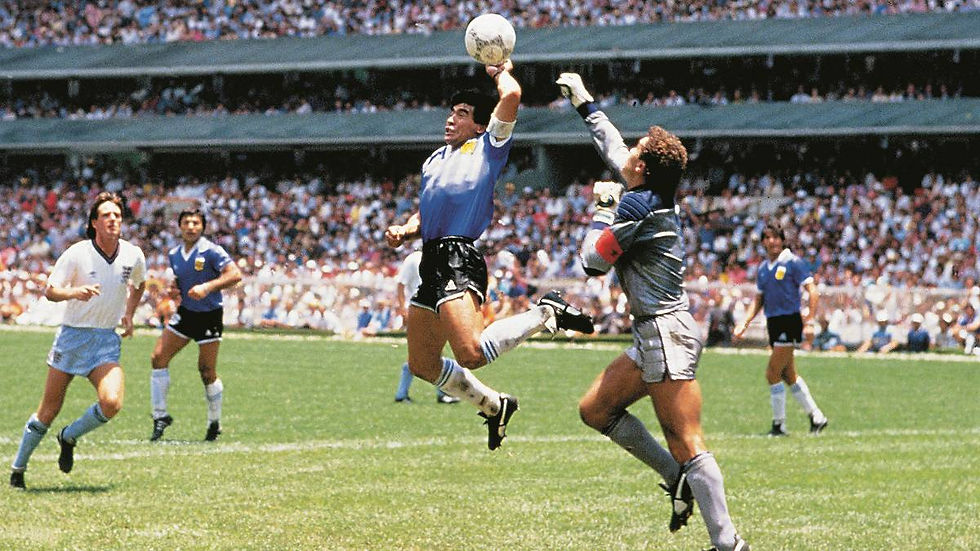Diego Maradona - The Duality of Il Dio
- ConnorNorcott

- Jun 21, 2019
- 4 min read
With the release of Diego Maradona, Asif Kapadia has perfectly rounded off his triumvirate of documentaries in stunning fashion. Starting with Senna, which brought light to the infamous, eponymous racing driver; portraying his rockstar-esque antics and rivalry with nemesis Alain Prost in a manner that captivated audiences who, like myself, were antipathetic with the sport of Formula 1. Following this was the more widely-recognised Amy, charting the tragic downfall of one of Britain’s most-talented artists Amy Winehouse, Kapadia explored her break taking talent, ever-rising fame and personal struggles that took their toll, in a powerful, heart-breaking documentary. So, when I became aware that Kapadia was basing his next film on the life of Diego Armando Maradona, I was already anticipating scandalous revelations into the life of one of football’s most iconic characters.

In truth, the tales of Maradona’s escapades formed the foundation of my opinion on the man, the myth. Bolstered by some highlight videos and vague memories of his failed management of Argentina in 2010, my awareness of his genius and reputation on the pitch was only through passing, I’d never had the chance to witness it – until I watched this film. Kapadia and his team collected over 500 hours of additional, unseen footage of Diego, which documented his life on and off the pitch and through careful restoration we’re able to witness his guile, tenacity and speed in stunning quality. While there are some glimpses of his early career in Argentina and Barcelona, the film centres on his spell at the (now) Italian giants Napoli, which saw him reach the peak of his talent and consequently, his infamy.
The film opens in a bold, breath-taking manner depicting a car chase that harks back to the likes of Peter Collinson's The Italian Job - cars racing through the tight, densely populated streets of Naples. We’re unaware that the destination is the legendary San Paolo, the Neapolitan coliseum, where Maradona is to be unveiled as the most expensive player in history. Kapadia and his editor Chris King inter-cut highlights of Diego’s early career, along with injuries and interviews with family and fellow players to punctuate the high-octane chase scene, brilliantly scored with a pulsating dance number, indicative of the night-life often associated with the Argentine star. This exemplifies the strength of Kapadia’s talent as a filmmaker; his choice of footage, music and the knowledge of when to cut enables him to create a narrative from material that wouldn’t have saw the light of day if not uncovered for the purpose of this film.
The film finds its central narrative when introducing Fernando Signorini, a fitness coach at Napoli who formed a great relationship with Diego, denoting a time where he confronted the star, telling the audience that there are two sides to the character of Diego Armando Maradona; there is Diego, self-proclaimed “momma’s boy” from the impoverished slums of Villa Fiorito, and there is Maradona, the tenacious, do-anything-to-win character who himself, tells us is the reason why he escaped his challenging background. Kapadia uses these conflicting personalities to keep the central, personal tension in mind when exploring the heroics, the scandals and the political turmoil that often catapulted him to headline news.

The break-neck pace established in the film is seemingly building to one crucial moment; 1990, World Cup Semi-Final, Italy vs Argentina in the San Paolo. Maradona, who after winning the league title with Napoli for this first time in their history, is now garnered with God-status and must take a pivotal penalty to knock Italy out of the World Cup. Score and he’s loved by his country; but at the cost of becoming the most-hated man in Italy (a label that was actually given to him) and in a stunning one shot, solely focused on the man of the hour, he scores, celebrates and instantly becomes the villain of his own story, while uniting a formerly divided Italy, through a collective hatred for El Pibe de Oro.
In fact, Kapadia’s film showcases just how a perfect storm of talent, outside influence, and internal struggle can fortify a character like ‘Maradona’. At the height of his ability on the field, he was denouncing his fatherhood to a child born out of an affair, becoming addicted to Cocaine and deeply entangled with the Giuliano crime family. Duality is at the heart of Diego Maradona, a man whose deification ultimately led to his downfall, and whose story is one that depicts the tragic dark side of celebrity.
Despite my stance as a staunch lover of ‘the beautiful game’, I believe that like Senna and Amy, Kapadia has found a way to universalise a story that is specific to a character as entrenched in their world, as Diego Maradona. The film feels less like a documentary and more like a spectacular, excessive gangster film in the vein of Scorsese’s Goodfellas. Racing through its run-time in a manner that provokes and challenges but most importantly allows you to empathise, whether football fan or not, it’s a joy to marvel in the beautiful bastardry of Diego Maradona. A must watch, especially in cinemas!



Comments